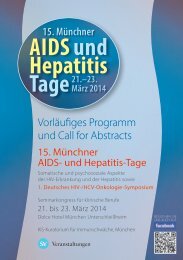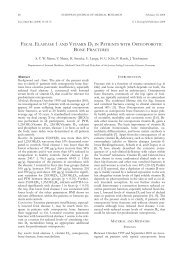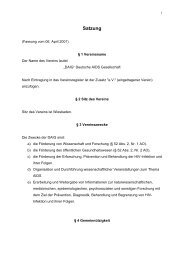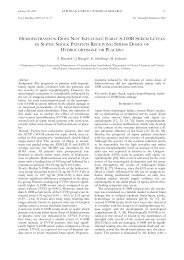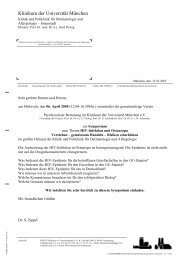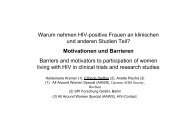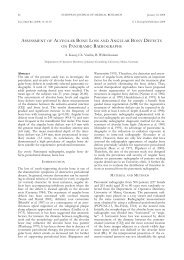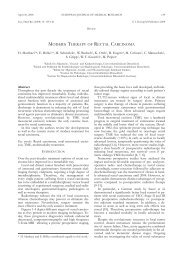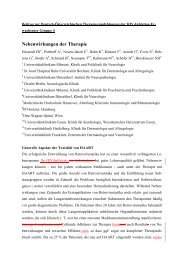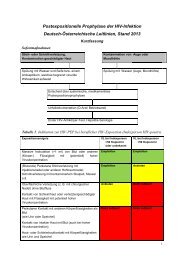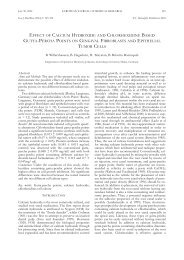European Journal of Medical Research - Deutsche AIDS ...
European Journal of Medical Research - Deutsche AIDS ...
European Journal of Medical Research - Deutsche AIDS ...
Create successful ePaper yourself
Turn your PDF publications into a flip-book with our unique Google optimized e-Paper software.
June 27, 2007 EUROPEAN JOURNAL OF MEDICAL RESEARCH<br />
33<br />
Conclusion: Socio-economic status have an impact on<br />
knowledge about health and as expected integrated (well German<br />
speaking) women are observed to be also integrated into<br />
the health system; they knew more about the illnesses. The<br />
most important challenge for <strong>AIDS</strong> prevention is to spread intensively<br />
the knowledge about <strong>AIDS</strong> and for better results in<br />
the mother language <strong>of</strong> migrants.<br />
A.19 (Poster)<br />
Prevalence <strong>of</strong> Neurosyphilis (NSI) diagnosed by<br />
Cerebrospinal Fluid (CSF) and clinical<br />
neurological examinations in HIV-positive patients<br />
with primary or secondary infectious Syphilis (SI)<br />
and CSF-repuncture for therapy control after<br />
treatment<br />
Esser S. 1 , Jablonka R. 1 , Körber A. 1 , Ross B. 1 ,<br />
Obermann M. 2 , Hagedorn H.J. 3 , Grabbe S. 1<br />
1 Universitätsklinikum Essen, Dermatologie und Venerologie,<br />
Essen, Germany, 2 Universitätsklinikum Essen, Neurologie,<br />
Essen, Germany, 3 Medizinal-Untersuchungsstelle im<br />
Regierungsbezirk Detmold, Konsiliarlabor Dr. Krone &<br />
Partner, Herford, Germany<br />
Objectives: Since 2000 prevalence <strong>of</strong> SI increased in Germany.<br />
SI cases showed rapid progression <strong>of</strong> SI to NSI and<br />
therapy failure in HIV-infected patients. The aim <strong>of</strong> the study<br />
is to evaluate signs for NSI in CSF in patients with co-infection<br />
<strong>of</strong> SI and HIV from January 2000 till February 2006.<br />
Methods: This prospective ongoing study included HIV-positive<br />
Patients with serological (TPHA, VDRL, IgM Western<br />
Blot) and clinical diagnosed primary or secondary SI. Neurological<br />
examinations and CSF puncture were performed and<br />
repuncture 12 months after treatment (TPHA, TPHA- ratio,<br />
FTA-ABS-19s-IgM, blood-CSF-barrier).<br />
Results: 94% <strong>of</strong> the 47 male patients (CDC WHO stage A<br />
17%, B 68%, C 15%; mean age 37 yrs) were described as men<br />
who have sex with men, three were heterosexual. Mean CD4cell<br />
count was 469/�l (range 81-1164) and mean HIV-RNA<br />
48497 copies/ml (range 50–500000). 31 (66%) patients were<br />
treated with antiretroviral therapy. Nine patients (19%)<br />
showed infectious seropositive SI without dermatological<br />
symptoms and 35 (74%) showed makulo-papular exanthema.<br />
All IgM-Western Blots were positive. Mean TPHA was<br />
1:1299885 (range 1:1280-1:41943040), mean VDRL 1:634<br />
(1-1:8192). Mean CSF-TPHA was 1:387 (range 1:2-1:8192),<br />
in repuncture <strong>of</strong> actual 13 patients 1:32 (range 0-1:128). Nine<br />
(19%) patients had a positive FTA-ABS-19s-IgM in CSF.<br />
Neurological symptoms were verified by a neurologist in<br />
three patients. At least a neurological attendance <strong>of</strong> SI was diagnosed<br />
in seven cases (15%) followed by intravenous Penicillin<br />
G therapy for 21 days. The others got intramuscularly<br />
treatment with Benzathinpenicillin for 14 days. In repuncture<br />
one year after treatment neither treatment failure nor positive<br />
CSF-FTA-ABS-19s-IgM titer was observed after therapy.<br />
Conclusions: 15 % <strong>of</strong> the HIV-positive patients with infectious<br />
SI had signs <strong>of</strong> early NSI. No treatment failure was observed<br />
in repuncture. This survey shows increased risk <strong>of</strong> NSI<br />
in HIV-Infected patients but obviously no treatment failure<br />
after sufficient therapy.<br />
A.20 (Poster)<br />
Impact <strong>of</strong> GB virus-C co-infection and quality <strong>of</strong><br />
life in a cohort <strong>of</strong> HIV infected patients in a<br />
private clinic in Germany<br />
Kaiser T. 1 , Kuhlmann B. 2 , Holm S. 2 , Weimann M. 2 ,<br />
Stoll M. 3 , Tillmann H.L. 1<br />
1 Universitätsklinikum Leipzig, Medizinische Klinik &<br />
Poliklinik II, Leipzig, Germany, 2 Internistische<br />
Gemeinschaftspraxis Georgstraße, Hannover, Germany,<br />
3 Medizinische Hochschule Hannover, Klinische Immunologie,<br />
Hannover, Germany<br />
Objective: GB Virus C is a non-pathogenic Flavivirus genetically<br />
closely related to the Hepatitis C Virus, which was<br />
found in relation to a better clinical course <strong>of</strong> infected HIVpatients<br />
in the pre-HAART era. Aim <strong>of</strong> this study was to investigate<br />
the effect on HIV viral load, CD4 and CD8 cells and<br />
also the quality <strong>of</strong> life in a cross sectional patient cohort from<br />
a private clinic in Germany in HAART era.<br />
Methods: 248 patients were analysed for HIV and GBV-C viral<br />
load, CD4 and CD8 cells. In addition, quality <strong>of</strong> life has<br />
been evaluated in 115 cases by using the SEL questionnaire<br />
and analysed in relation to GBV-C status.<br />
Results: There was a trend though not significant towards<br />
better results for HIV-viral load, CD4 and CD8 cells in the<br />
GBV-C positive patients. Although not reaching the level <strong>of</strong><br />
significance in this study, the positive trend was the same in<br />
whatever sub analysis performed.<br />
Likewise, the quality <strong>of</strong> life was better, though not significantly,<br />
for GBV-C co-infected patients. Limiting the analysis<br />
to patients not yet receiving HAART showed even significant<br />
better QoL for GBV-C viraemic patients (p=0.039).<br />
Discussion: The availability <strong>of</strong> HAART seems to diminish<br />
but not eliminate GBV-C’s role in slower disease progression<br />
and better quality <strong>of</strong> life in HIV infected patients.<br />
Key words: GBV-C, HGV, HIV, co-infection, QoL, quality<br />
<strong>of</strong> life.<br />
A.21 (Vortrag)<br />
KABaSTI-study results: Barebacking among<br />
German men who have sex with men (MSM) - risk<br />
reduction intentions and practice<br />
Marcus U. 1 , Schmidt A.J. 1 , Hamouda O. 1<br />
1 Robert Koch-Institut, Infektionsepidemiologie, Berlin,<br />
Germany<br />
Objectives: During the last decade “barebacking” (intentional<br />
non-use <strong>of</strong> condoms for anal intercourse with casual partners<br />
in MSM) has become increasingly popular. There has been no<br />
study on sexual risk behaviour and risk management strategies<br />
in MSM with bareback identities in Germany so far.<br />
Methods: Within a larger internet survey on knowledge, attitudes,<br />
and behaviour <strong>of</strong> German MSM as to sexually transmitted<br />
infections, we analysed reported sexual risk behaviour and<br />
risk management intentions <strong>of</strong> survey participants recruited<br />
on bareback websites (BBW) compared to participants recruited<br />
on other websites (OW).<br />
Results: BBW (n=564) were significantly older (77% vs.<br />
59% older than 30 years), had been tested for HIV more frequently<br />
(91% vs. 67%), a much higher proportion was HIV<br />
positive (59% vs. 10%), and were living more <strong>of</strong>ten in metropolitan<br />
areas (37% vs. 24%) than OW (n=5364). BBW report-



